Note
✨🌈SEND THIS TO OTHER BLOGGERS YOU THINK ARE WONDERFUL. KEEP THE GAME GOING🌈✨
THIS IS SO CUUUUUUUTE
THANK YOU!!
3 notes
·
View notes
Text
Is that piece of media actually bad or did it just not go the way you wanted it to go?
18K notes
·
View notes
Text
#I’m guessing every person that touched him and died#gave him their lifespan or something
@doomedbythe-narrative sorry to tag unprompted but that's one of my favorite Fyodor ability theories!!
I just love that thought, thank you. If that's what it is, surely there'll be some conditions to how and to who he can do it to, but it'd be absolutely amazing if he's "practically immortal" due to having taken the lifespan of a huge amount of sinners.
Fyodor ability theories are so so so welcome right now, I'm loving this.
All I gotta say about BSD 113 is:
Told ya! Fyodor's not gonna be dead lmao
His ability may be something along the lines of longevity, immortality, life-stealing, rebirth or such... hmmm.
91 notes
·
View notes
Text
All I gotta say about BSD 113 is:
Told ya! Fyodor's not gonna be dead lmao
His ability may be something along the lines of longevity, immortality, life-stealing, rebirth or such... hmmm.
91 notes
·
View notes
Note
can u make one analistpost like the toman and tenjiku but for the other gangs. i was wondering if the headless angel of valhalla had a viking meaning. ty u for the post, it was really well put together and easy to understand
Yeah, totally! The other gangs aren't as heavy in references a Toman and Tenjiku, so the explanations would come out much shorter, but I can make a collection post to cover all the other ones, Valhalla included.
Replying now to say yes haha, I'll work on it asap and be posting it soon!
Thanks for reading the Toman+Tenjiku post!! I'm very happy to have people to share n talk about these things with!
#asks#yayyyyy#gonna write more meta!!#i have a little post finished that i have to upload but its about something else#will definitely work on this one then!
1 note
·
View note
Note
do you think mucho would be into hanafuda?
HUH
ACTUALLY
ABSOLUTELY, YEAH
Because he plays shogi!

Shogi is really classical (and complicated, like chess on steroids), so it kinda seems on brand that he'd like other traditional games. Suits his taste for strategy and apparent preference for chill activities.
Koi-koi is the main game played with hanafuda cards, it's not super hard to play per se, just difficult to pick up because you have to KNOW hands and combos and values without all of them being intuitive. I'd bet he knows how to play through and through! I bet he's great at mind-gaming his opponents too!
16 notes
·
View notes
Text
An update!
An extra point has been added to the Tokyo Manji Gang section. Something that I somehow forgot about when writing even though it's often right in fron of my face, haha, sorry, sorry.
Toman and Buddhism + Tenjiku and Taoism
Another post to cover references in Tokyo Revengers!
This time, I'll be covering the links to two religions to be found in two gangs in the series, reference by reference, with the according explanation of each.
Some of these may be already known, I know one of them sure is (the whole buddhist manji confusion thing yeah yeah) but still, for the sake of a tidy compilation and of providing more detail, I'll go through them too. Some others are a lot less noticed, like Tenjiku's lean towards Tao, so it'll be best to lay down eeeeeeverything I've caught during my time enjoying this series. Plus, I'm pretty excited to get some of those less-known facts out here!!
Warning though, it's lengthy.
Let's start with Tokyo Manji Gang:

- Firstly, the gang's name and how it's written.
Despite Mikey suggesting the name as a short form of Tokyo Manjiro Gang, putting himself front and center, the kanji that ended up forming the name of Tokyo Manji Gang show that it went in a different direction of meaning. The manji used for the middle part ended up not being the same one from the name Manjiro, but a manji written as 卍. Aloud it's read the same way (many, many, many kanji are homophones), but has a different meaning.
卍 (manji) is an extremely common buddhist symbol (not even limited to japanese buddhism, but in hinduism and other aligned east-asian religions too), which represents the path of Buddha and the endless cycle of rebirth through samsara; the pursuit of leading a more spiritually balanced existence until the soul can reach enlightenment. In other words, it's nothing but deeply buddhist.
(To answer a common question around it: can it be called a swastika? Yes. The symbol in general, with each of the million variations that have popped up in different cultures, can be called a swastika as a broad term. There are a fuckton of swastikas. They mean a fuckton of different things. The tilt and the direction in which this one "spins" makes it different from other swastikas though, and it's always best to be precise and call this one manji.)
Moving on,
- Reunion spot.


The Musashi Shrine (based, but not exactly taken from any of the real-life shrines and temples of similar name in Tokyo, as far as I know) is a shinto-buddhist temple. And, apparently, a place where the founders hung out from time to time, but I'll add to that later!!
It's cute to me that the Toman members seem to use the temple very respectfully. They always meet in it at night waaay after it's closed (daytime meetings have always taken place in different locations, never the temple during visiting hours), they've never once set foot even near the oratory/sanctum/other buildings, never been seen bringing the motorcycles anywhere they shouldn't, and the one time a character was seen using the public temizuya (the little stone fountain where visitors purify their hands and mouth), he was proper about it in terms of pouring water into his hand to rinse his mouth with, not getting the ladle or the rest of the water dirty, as one should always do.
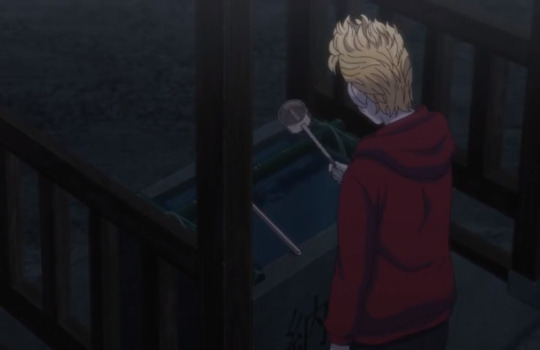
A fun fact: in Google Maps, buddhist temples are marked with the manji symbol!
- Gang's manifesto.

Embroidered on the chest of the gang uniform, you can see the text 天上天下唯我独尊 ("Above the earth and below the heavens, I alone shall be honored"), which is the gang's manifesto or motto. Sounds just like something Mikey would choose, yeah.
That phrase is also of buddhist origin; famously, the words spoken by Buddha Gautama Siddharta (bear in mind that buddhism isn't a religion with one god or anything like that, anyone enlightened can become a Buddha and many figures have been granted that status, but Gautama is the first and main one, the creator of the doctrine) when he was born. To be honest, this is very much interpretative, but I've come to get the impression that it's not so much a power or ego statement, but rather an expression of cultivating and honoring yourself…? It's absolutely up to personal reading and I'm absolutely not an expert. But those are certainly THE Buddha's words.
- Ceremonial sash.

Another part of their uniform that bears a slight reference: the sash worn by the commander, vice-commander, captains and vice-captains during important fights.
These are tasuki, sashes originally worn by shinto-buddhist priests during ceremonies, in order to keep long sleeves and such in place. However, over time they also began being worn by samurai and all sorts of warriors, 'cause of their convenience. In modern times, they even started being used by just about anybody who wears traditional clothing but also does manual work and needs the sleeves out of the way. So, over time, they stopped being strongly linked to religious practicers. In fact, biker gangs in general ended up adopting the use of tasuki! Not for their religious origins, but for the warrior part; a bōsōzoku gang member wearing one would look very prepared and determined for a fight.
So overall, Tokyo Manji Gang having them is only a relative reference; they could be paying homage to local religion, as they could be only honoring gang traditions.
- Additional notes about the leader.
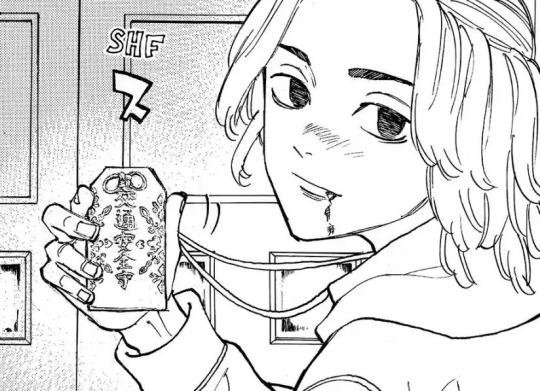
I feel it's important to add up all these little factors of Mikey's choosing, with other little details about him as a person that kinda make it all make sense.
If I say "Mikey seems to be religious, to an extent", I understand this can carry a bunch of tricky connotations. Japanese religion isn't exercised the same way it is in other places, someone being religious SURE AS HECK doesn't mean the same things it means in the christian west. Shinto-buddhism is so commonplace in Japan, most people partake in all kinds of religious practices without even thinking of them as strictly religious, such as new year's celebrations, casual prayer during shrine visits, purchasing and giving charms and such. Religion is integrated in life in a lot of extremely chill ways.
And we can observe a lot of things about Mikey that put him quite above the average in terms of his relationship with local tradition and religion. His house is a huge traditional-style family home, his family is hinted to be active in religious practice (remember Emma's appearances during the Christmas Showdown arc? How she mentioned that their family does a lot of temple visits, and even she considered it weird at that time of the year?), he's much more prone to wearing traditional clothing than his peers, his motif in extra clothing designs is the lion-dog (temple guardians; statues of these can often be found in them), his personal beliefs around death and relationship to the dead run deeper than others' to the point they find him disturbing when he talks about Shinichiro or Baji still being with him... many little things that aren't that deep on their own, of course, but when added up they paint a pretty coherent picture of the guy.
And so, it does make a lot of sense that, even from childhood, a temple was a regular place for Mikey to hang out with his friends, leading to the birth of Toman in one. And it makes a lot of sense that he made all those little choices about the way the gang would be styled. In my opinion, it's likely that those things just all came natural to him because they're a part of his background and worldview. Of course, how actively religious he is, how much he believes in the things he happens to know and how much exactly he might know about buddhism are all up to headcanoning and interpretation. Personally, I'm just a roleplayer that takes it as a relevant part of his character.
- Following a Buddha?
A little out-of-TR-universe element that I love to bring up, 'cause it's just hilarious and cool as hell, is the creation of this statue:
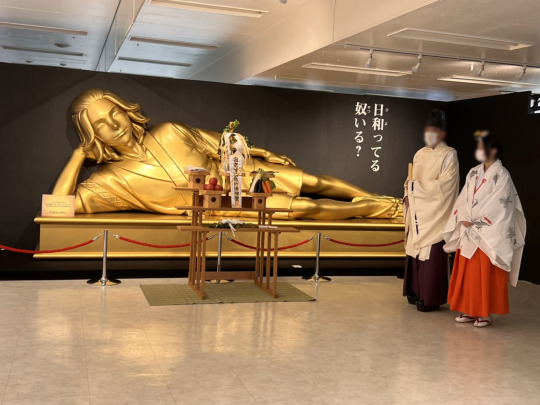
This part of the 2022 Tokyo Revengers exhibition straight up imitates the famous Reclining Buddha in the Wat Pho temple, Thailand.
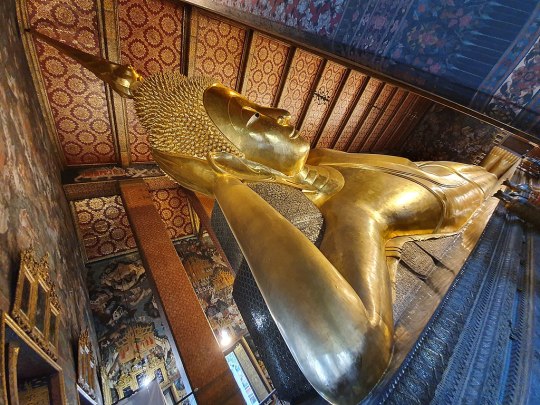
The ENORMOUS statue depicts the moment Buddha reaches nirvana, and his enlightened soul is at rest. The golden Mikey statue that imitates it very much intentionally likens him to a Buddha; funny to note that the exhibition staff even prayed to the statue, as you can read in the tweet itself.
What does this mean about Mikey's character? Well, this isn't within text in Tokyo Revengers, just a little outside factor, so I wouldn't take it too literally or too seriously, but it's interesting nonetheless. Personally, I see it as a hint that Mikey was supposed to be on his own little quest to enlightenment, or had the potential to be. Grappling with morality without having a natural sense of what's right, wrong, too much or enough is a major thing with his character. I can also imagine it might just be meant to represent the godlike view others have of him, the guidance they sought from him. Take it as you will!
The important thing is just that it exists, to confirm that there is an intentional connection of some type between the Buddha and Mikey.
Thaaaaat concludes the Toman and Buddhism section of this post.
Whew!! That was a whole lot.
The Tenjiku and Taoism section coming now is shorter, but I'm sure it contains interesting and less-known things (at least, I've never seen anybody talk about these)!
So let's see, Tao references in Tenjiku:

- Gang name.
Tenjiku is a now-obsolete word that translated directly to "heaven", while simultaneously being the japanese word for the country India (as taken from the chinese pronunciation, Tianzhu).
In modern times, it can be found mostly in ancient literature, the most prominent example being Journey to the West. Given that Kakucho and Izana mentioned this book and seemed to have knowledge of it as kids, we can conclude that's where they got the name of their gang from.
Why would they use the word for India to name their kingdom? What does this have to do with Tao? I'll get into that properly now:
- Kakucho, Izana & Journey to the West.

Journey to the West is one of the four great chinese classic novels (along with Romance of the Three Kingdoms, Outlaws of the Marsh, and Dream of the Red Chamber) which are enormous, ENORMOUS influences on east-asian literature and fiction in general. Journey to the West, itself, is considered the most popular east-asian literary work overall; of course, being super well-known in Japan, too. (To give my favorite funny example of just how omnipresent it is, y'know Dragon Ball? Hit anime series Dragon Ball? Unabashedly based on Journey to the West, which was to thank for most of its initial local popularity.)
It's the story of the buddhist monk Tang Sanzang, who travels to Tenjiku, to India, to that certain heavenly kingdom, to obtain sacred texts for Buddha Gautama Siddharta (the guy I described as THE Buddha in the Tokyo Manji Gang section above). The quest doubles as a search and exercise of enlightenment, as Tang Sanzang is aided by three protectors that are atoning for their sins and learning from him. The main guardian and arguably the true protagonist of the book is Sun Wukong, the Monkey King, a fighter "so strong he could carry a mountain on each shoulder, and still dash as fast as a meteor". It's a huge, epic, 100-chapter monster of a book, in which each chapter is already a fantastic and entertaining anecdote about the characters or what happens in their travels, but also a long spiritual journey that pretty much serves to subtly teach the principles of Tao (term that can be translated to "the path", chinese religion and philosophy).
A tangent: let me just show you how large it is (and why I haven't been able to finish it, 'cause I cannot take this brick of a book anywhere lmaoooo).
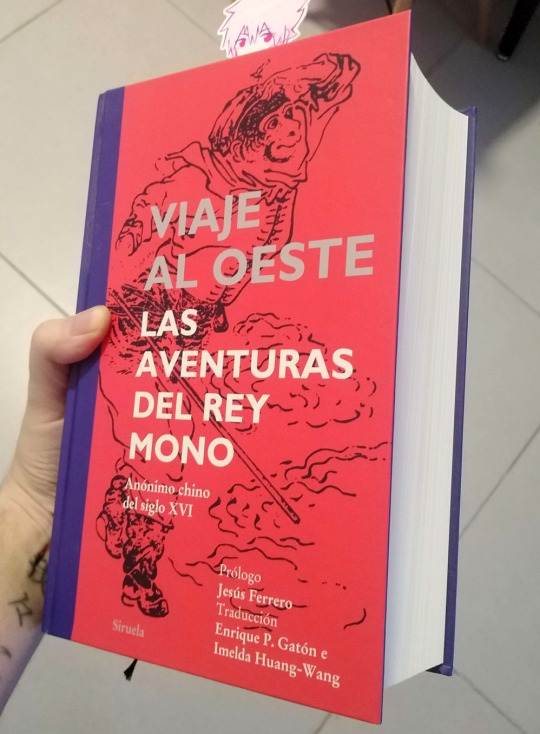
(Cover says Journey to the West: The Adventures of the Monkey King. It's in spanish.)
My guess is that Izana and Kakucho studied about it or read some chapters in school, 'cause dang, there's no way they read all of this at that age?!?! BUT ANYWAY.
While there's obviously quite some buddhist influence in the story, most of what it works with throughout is rooted in chinese folklore and Taoism. The edition of the book I have even begins with extensive notes and introductory explanations about Tao, as its themes of harmony with the universe, self-cultivation, internal alchemy, its main ethics and values, etc etc etc are the basis from which the book is built up. The characters very actively engage with Tao. Sun Wukong is an ardent student of Tao who obtains a bunch of powers through it, for one.
I've gone into this much into detail because Kakucho and Izana make it pretty explicit that, to them, Izana is like monk Tang Sanzang leading to Tenjiku, and Kakucho is like his guardian of unmatched strength, Sun Wukong.
In the end of Journey to the West, it's both Tang Sanzang and Sun Wukong that accomplish their goal and also obtain enlightenment, finally ascending to buddhahood. Had Izana and Kakucho's journey with Tenjiku reached their original destination (not "to become a criminal syndicate that controls Japan" but "to build a kingdom where everyone without a home could exist"), had it been like Tang Sanzang and Sun Wukong's pilgrimage… they would've learned true balance and they would've found the necessary enlightenment.
Again, I find this little connection with characters that could've been on a quest towards buddhahood, but as far as things went in the main TR timelines, all failed.
- Uniform & logo.
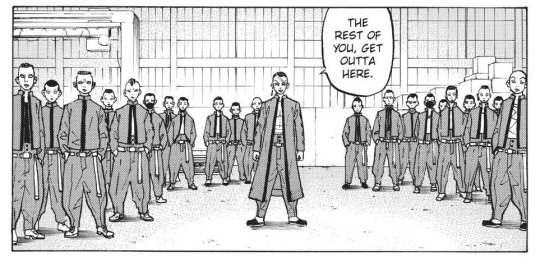
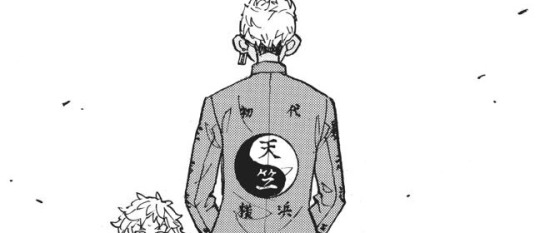
Finally, something lighter and quicker to add, haha.
There are symbols and references that are so so so widespread that they become more of an aesthetic detail than a symbol with meaning, in the eyes of the general public. The yin-yang is one of those symbols that just… appears in a lot of places, fashionably, and one kinda gets used to seeing it without thinking much about it. Sometimes it's not meant to stand for much more than a decorative detail, yes, that definitely happens, but sometimes it's very much a thoughtful choice. With Tenjiku, given its connection to Taoism, I'm gonna treat the yin-yang as a meaningful choice.
So! On the back of the uniform we have a yin-yang, Taoist symbol that represents the balance of the two complementary and opposing forces of the universe (note: it's not a good vs evil type of thing, as tends to happen with western black-white dualism, but rather… the fact that reality needs to be composed of push and pull to get anywhere, hard and soft things with their own function, sun and shade. A common comparison is how a mountain will have a sunny side and a shady side when looked at in a certain moment, but the sun and shade will switch over at another time of day, in a needed cycle). Other features of the uniform are a mao collar instead of a more common style for gang jackets, and an intense red color, the main auspicious and prosperous color in chinese culture. These last two little features could easily be coincidental, but when paired with the yin-yang, I feel like it's intended to lean towards chinese aesthetics.
And with that,
I end this reference post!
Did you learn anything you didn't know? Did you enjoy learning it? Any thoughts? I LOVE TO TALK ABOUT THESE THINGS, SO FEEL FREE TO DROP BY MY ASKBOX with any comments or questions or such!!
163 notes
·
View notes
Text
Headcanons are amazing. I can just decide on anything, whether it be a projection, a whim, a fancy, crack madness and point at a character and go "you. This is you" Kinda feels illegal to be able to have such fun unchecked and unrestrained
#too real to pass up#headcanoning is my daily serotonin#i could be doing anything and im like HEY YOU KNOW WHICH CHARACTER WOULD BE GOOD/BAD AT THIS--
9 notes
·
View notes
Text
Thanks a million!! I love collecting extra details and laying them out, happy to have people who enjoy them too!!
Toman and Buddhism + Tenjiku and Taoism
Another post to cover references in Tokyo Revengers!
This time, I'll be covering the links to two religions to be found in two gangs in the series, reference by reference, with the according explanation of each.
Some of these may be already known, I know one of them sure is (the whole buddhist manji confusion thing yeah yeah) but still, for the sake of a tidy compilation and of providing more detail, I'll go through them too. Some others are a lot less noticed, like Tenjiku's lean towards Tao, so it'll be best to lay down eeeeeeverything I've caught during my time enjoying this series. Plus, I'm pretty excited to get some of those less-known facts out here!!
Warning though, it's lengthy.
Let's start with Tokyo Manji Gang:

- Firstly, the gang's name and how it's written.
Despite Mikey suggesting the name as a short form of Tokyo Manjiro Gang, putting himself front and center, the kanji that ended up forming the name of Tokyo Manji Gang show that it went in a different direction of meaning. The manji used for the middle part ended up not being the same one from the name Manjiro, but a manji written as 卍. Aloud it's read the same way (many, many, many kanji are homophones), but has a different meaning.
卍 (manji) is an extremely common buddhist symbol (not even limited to japanese buddhism, but in hinduism and other aligned east-asian religions too), which represents the path of Buddha and the endless cycle of rebirth through samsara; the pursuit of leading a more spiritually balanced existence until the soul can reach enlightenment. In other words, it's nothing but deeply buddhist.
(To answer a common question around it: can it be called a swastika? Yes. The symbol in general, with each of the million variations that have popped up in different cultures, can be called a swastika as a broad term. There are a fuckton of swastikas. They mean a fuckton of different things. The tilt and the direction in which this one "spins" makes it different from other swastikas though, and it's always best to be precise and call this one manji.)
Moving on,
- Reunion spot.


The Musashi Shrine (based, but not exactly taken from any of the real-life shrines and temples of similar name in Tokyo, as far as I know) is a shinto-buddhist temple. And, apparently, a place where the founders hung out from time to time, but I'll add to that later!!
It's cute to me that the Toman members seem to use the temple very respectfully. They always meet in it at night waaay after it's closed (daytime meetings have always taken place in different locations, never the temple during visiting hours), they've never once set foot even near the oratory/sanctum/other buildings, never been seen bringing the motorcycles anywhere they shouldn't, and the one time a character was seen using the public temizuya (the little stone fountain where visitors purify their hands and mouth), he was proper about it in terms of pouring water into his hand to rinse his mouth with, not getting the ladle or the rest of the water dirty, as one should always do.

A fun fact: in Google Maps, buddhist temples are marked with the manji symbol!
- Gang's manifesto.

Embroidered on the chest of the gang uniform, you can see the text 天上天下唯我独尊 ("Above the earth and below the heavens, I alone shall be honored"), which is the gang's manifesto or motto. Sounds just like something Mikey would choose, yeah.
That phrase is also of buddhist origin; famously, the words spoken by Buddha Gautama Siddharta (bear in mind that buddhism isn't a religion with one god or anything like that, anyone enlightened can become a Buddha and many figures have been granted that status, but Gautama is the first and main one, the creator of the doctrine) when he was born. To be honest, this is very much interpretative, but I've come to get the impression that it's not so much a power or ego statement, but rather an expression of cultivating and honoring yourself…? It's absolutely up to personal reading and I'm absolutely not an expert. But those are certainly THE Buddha's words.
- Additional notes about the leader.

I feel it's important to add up all these little factors of Mikey's choosing, with other little details about him as a person that kinda make it all make sense.
If I say "Mikey seems to be religious, to an extent", I understand this can carry a bunch of tricky connotations. Japanese religion isn't exercised the same way it is in other places, someone being religious SURE AS HECK doesn't mean the same things it means in the christian west. Shinto-buddhism is so commonplace in Japan, most people partake in all kinds of religious practices without even thinking of them as strictly religious, such as new year's celebrations, casual prayer during shrine visits, purchasing and giving charms and such. Religion is integrated in life in a lot of extremely chill ways.
And we can observe a lot of things about Mikey that put him quite above the average in terms of his relationship with local tradition and religion. His house is a huge traditional-style family home, his family is hinted to be active in religious practice (remember Emma's appearances during the Christmas Showdown arc? How she mentioned that their family does a lot of temple visits, and even she considered it weird at that time of the year?), he's much more prone to wearing traditional clothing than his peers, his motif in extra clothing designs is the lion-dog (temple guardians; statues of these can often be found in them), his personal beliefs around death and relationship to the dead run deeper than others' to the point they find him disturbing when he talks about Shinichiro or Baji still being with him... many little things that aren't that deep on their own, of course, but when added up they paint a pretty coherent picture of the guy.
And so, it does make a lot of sense that, even from childhood, a temple was a regular place for Mikey to hang out with his friends, leading to the birth of Toman in one. And it makes a lot of sense that he made all those little choices about the way the gang would be styled. In my opinion, it's likely that those things just all came natural to him because they're a part of his background and worldview. Of course, how actively religious he is, how much he believes in the things he happens to know and how much exactly he might know about buddhism are all up to headcanoning and interpretation. Personally, I'm just a roleplayer that takes it as a relevant part of his character.
- Following a Buddha?
A little out-of-TR-universe element that I love to bring up, 'cause it's just hilarious and cool as hell, is the creation of this statue:

This part of the 2022 Tokyo Revengers exhibition straight up imitates the famous Reclining Buddha in the Wat Pho temple, Thailand.

The ENORMOUS statue depicts the moment Buddha reaches nirvana, and his enlightened soul is at rest. The golden Mikey statue that imitates it very much intentionally likens him to a Buddha; funny to note that the exhibition staff even prayed to the statue, as you can read in the tweet itself.
What does this mean about Mikey's character? Well, this isn't within text in Tokyo Revengers, just a little outside factor, so I wouldn't take it too literally or too seriously, but it's interesting nonetheless. Personally, I see it as a hint that Mikey was supposed to be on his own little quest to enlightenment, or had the potential to be. Grappling with morality without having a natural sense of what's right, wrong, too much or enough is a major thing with his character. I can also imagine it might just be meant to represent the godlike view others have of him, the guidance they sought from him. Take it as you will!
The important thing is just that it exists, to confirm that there is an intentional connection of some type between the Buddha and Mikey.
Thaaaaat concludes the Toman and Buddhism section of this post.
Whew!! That was a whole lot.
The Tenjiku and Taoism section coming now is shorter, but I'm sure it contains interesting and less-known things (at least, I've never seen anybody talk about these)!
So let's see, Tao references in Tenjiku:

- Gang name.
Tenjiku is a now-obsolete word that translated directly to "heaven", while simultaneously being the japanese word for the country India (as taken from the chinese pronunciation, Tianzhu).
In modern times, it can be found mostly in ancient literature, the most prominent example being Journey to the West. Given that Kakucho and Izana mentioned this book and seemed to have knowledge of it as kids, we can conclude that's where they got the name of their gang from.
Why would they use the word for India to name their kingdom? What does this have to do with Tao? I'll get into that properly now:
- Kakucho, Izana & Journey to the West.

Journey to the West is one of the four great chinese classic novels (along with Romance of the Three Kingdoms, Outlaws of the Marsh, and Dream of the Red Chamber) which are enormous, ENORMOUS influences on east-asian literature and fiction in general. Journey to the West, itself, is considered the most popular east-asian literary work overall; of course, being super well-known in Japan, too. (To give my favorite funny example of just how omnipresent it is, y'know Dragon Ball? Hit anime series Dragon Ball? Unabashedly based on Journey to the West, which was to thank for most of its initial local popularity.)
It's the story of the buddhist monk Tang Sanzang, who travels to Tenjiku, to India, to that certain heavenly kingdom, to obtain sacred texts for Buddha Gautama Siddharta (the guy I described as THE Buddha in the Tokyo Manji Gang section above). The quest doubles as a search and exercise of enlightenment, as Tang Sanzang is aided by three protectors that are atoning for their sins and learning from him. The main guardian and arguably the true protagonist of the book is Sun Wukong, the Monkey King, a fighter "so strong he could carry a mountain on each shoulder, and still dash as fast as a meteor". It's a huge, epic, 100-chapter monster of a book, in which each chapter is already a fantastic and entertaining anecdote about the characters or what happens in their travels, but also a long spiritual journey that pretty much serves to subtly teach the principles of Tao (term that can be translated to "the path", chinese religion and philosophy).
A tangent: let me just show you how large it is (and why I haven't been able to finish it, 'cause I cannot take this brick of a book anywhere lmaoooo).

(Cover says Journey to the West: The Adventures of the Monkey King. It's in spanish.)
My guess is that Izana and Kakucho studied about it or read some chapters in school, 'cause dang, there's no way they read all of this at that age?!?! BUT ANYWAY.
While there's obviously quite some buddhist influence in the story, most of what it works with throughout is rooted in chinese folklore and Taoism. The edition of the book I have even begins with extensive notes and introductory explanations about Tao, as its themes of harmony with the universe, self-cultivation, internal alchemy, its main ethics and values, etc etc etc are the basis from which the book is built up. The characters very actively engage with Tao. Sun Wukong is an ardent student of Tao who obtains a bunch of powers through it, for one.
I've gone into this much into detail because Kakucho and Izana make it pretty explicit that, to them, Izana is like monk Tang Sanzang leading to Tenjiku, and Kakucho is like his guardian of unmatched strength, Sun Wukong.
In the end of Journey to the West, it's both Tang Sanzang and Sun Wukong that accomplish their goal and also obtain enlightenment, finally ascending to buddhahood. Had Izana and Kakucho's journey with Tenjiku reached their original destination (not "to become a criminal syndicate that controls Japan" but "to build a kingdom where everyone without a home could exist"), had it been like Tang Sanzang and Sun Wukong's pilgrimage… they would've learned true balance and they would've found the necessary enlightenment.
Again, I find this little connection with characters that could've been on a quest towards buddhahood, but as far as things went in the main TR timelines, all failed.
- Uniform & logo.


Finally, something lighter and quicker to add, haha.
There are symbols and references that are so so so widespread that they become more of an aesthetic detail than a symbol with meaning, in the eyes of the general public. The yin-yang is one of those symbols that just… appears in a lot of places, fashionably, and one kinda gets used to seeing it without thinking much about it. Sometimes it's not meant to stand for much more than a decorative detail, yes, that definitely happens, but sometimes it's very much a thoughtful choice. With Tenjiku, given its connection to Taoism, I'm gonna treat the yin-yang as a meaningful choice.
So! On the back of the uniform we have a yin-yang, Taoist symbol that represents the balance of the two complementary and opposing forces of the universe (note: it's not a good vs evil type of thing, as tends to happen with western black-white dualism, but rather… the fact that reality needs to be composed of push and pull to get anywhere, hard and soft things with their own function, sun and shade. A common comparison is how a mountain will have a sunny side and a shady side when looked at in a certain moment, but the sun and shade will switch over at another time of day, in a needed cycle). Other features of the uniform are a mao collar instead of a more common style for gang jackets, and an intense red color, the main auspicious and prosperous color in chinese culture. These last two little features could easily de coincidental, but when paired with the yin-yang, I feel like it's intended to lean towards chinese aesthetics.
And with that,
I end this reference post!
Did you learn anything you didn't know? Did you enjoy learning it? Any thoughts? I LOVE TO TALK ABOUT THESE THINGS, SO FEEL FREE TO DROP BY MY ASKBOX with any comments or questions or such!!
163 notes
·
View notes
Text
Toman and Buddhism + Tenjiku and Taoism
Another post to cover references in Tokyo Revengers!
This time, I'll be covering the links to two religions to be found in two gangs in the series, reference by reference, with the according explanation of each.
Some of these may be already known, I know one of them sure is (the whole buddhist manji confusion thing yeah yeah) but still, for the sake of a tidy compilation and of providing more detail, I'll go through them too. Some others are a lot less noticed, like Tenjiku's lean towards Tao, so it'll be best to lay down eeeeeeverything I've caught during my time enjoying this series. Plus, I'm pretty excited to get some of those less-known facts out here!!
Warning though, it's lengthy.
Let's start with Tokyo Manji Gang:

- Firstly, the gang's name and how it's written.
Despite Mikey suggesting the name as a short form of Tokyo Manjiro Gang, putting himself front and center, the kanji that ended up forming the name of Tokyo Manji Gang show that it went in a different direction of meaning. The manji used for the middle part ended up not being the same one from the name Manjiro, but a manji written as 卍. Aloud it's read the same way (many, many, many kanji are homophones), but has a different meaning.
卍 (manji) is an extremely common buddhist symbol (not even limited to japanese buddhism, but in hinduism and other aligned east-asian religions too), which represents the path of Buddha and the endless cycle of rebirth through samsara; the pursuit of leading a more spiritually balanced existence until the soul can reach enlightenment. In other words, it's nothing but deeply buddhist.
(To answer a common question around it: can it be called a swastika? Yes. The symbol in general, with each of the million variations that have popped up in different cultures, can be called a swastika as a broad term. There are a fuckton of swastikas. They mean a fuckton of different things. The tilt and the direction in which this one "spins" makes it different from other swastikas though, and it's always best to be precise and call this one manji.)
Moving on,
- Reunion spot.


The Musashi Shrine (based, but not exactly taken from any of the real-life shrines and temples of similar name in Tokyo, as far as I know) is a shinto-buddhist temple. And, apparently, a place where the founders hung out from time to time, but I'll add to that later!!
It's cute to me that the Toman members seem to use the temple very respectfully. They always meet in it at night waaay after it's closed (daytime meetings have always taken place in different locations, never the temple during visiting hours), they've never once set foot even near the oratory/sanctum/other buildings, never been seen bringing the motorcycles anywhere they shouldn't, and the one time a character was seen using the public temizuya (the little stone fountain where visitors purify their hands and mouth), he was proper about it in terms of pouring water into his hand to rinse his mouth with, not getting the ladle or the rest of the water dirty, as one should always do.

A fun fact: in Google Maps, buddhist temples are marked with the manji symbol!
- Gang's manifesto.

Embroidered on the chest of the gang uniform, you can see the text 天上天下唯我独尊 ("Above the earth and below the heavens, I alone shall be honored"), which is the gang's manifesto or motto. Sounds just like something Mikey would choose, yeah.
That phrase is also of buddhist origin; famously, the words spoken by Buddha Gautama Siddharta (bear in mind that buddhism isn't a religion with one god or anything like that, anyone enlightened can become a Buddha and many figures have been granted that status, but Gautama is the first and main one, the creator of the doctrine) when he was born. To be honest, this is very much interpretative, but I've come to get the impression that it's not so much a power or ego statement, but rather an expression of cultivating and honoring yourself…? It's absolutely up to personal reading and I'm absolutely not an expert. But those are certainly THE Buddha's words.
- Ceremonial sash.

Another part of their uniform that bears a slight reference: the sash worn by the commander, vice-commander, captains and vice-captains during important fights.
These are tasuki, sashes originally worn by shinto-buddhist priests during ceremonies, in order to keep long sleeves and such in place. However, eventually, they also began being worn by samurai and all sorts of warriors, 'cause of their convenience. In modern times, they even started being used by just about anybody who wears traditional clothing but also does manual work and needs the sleeves out of the way. So it can be concluded that, over time, they stopped being strongly linked to religious practicers. In fact, even biker gangs in general ended up adopting the use of tasuki! Not for their religious origins, but for the warrior part; a bōsōzoku gang member wearing one would look very prepared and determined for a fight.
That's why overall, Tokyo Manji Gang having them is only a relative reference; they could be paying homage to their reference religion, as they could be only honoring gang traditions.
- Additional notes about the leader.

I feel it's important to add up all these little factors of Mikey's choosing, with other little details about him as a person that kinda make it all make sense.
If I say "Mikey seems to be religious, to an extent", I understand this can carry a bunch of tricky connotations. Japanese religion isn't exercised the same way it is in other places, someone being religious SURE AS HECK doesn't mean the same things it means in the christian west. Shinto-buddhism is so commonplace in Japan, most people partake in all kinds of religious practices without even thinking of them as strictly religious, such as new year's celebrations, casual prayer during shrine visits, purchasing and giving charms and such. Religion is integrated in life in a lot of extremely chill ways.
And we can observe a lot of things about Mikey that put him quite above the average in terms of his relationship with local tradition and religion. His house is a huge traditional-style family home, his family is hinted to be active in religious practice (remember Emma's appearances during the Christmas Showdown arc? How she mentioned that their family does a lot of temple visits, and even she considered it weird at that time of the year?), he's much more prone to wearing traditional clothing than his peers, his motif in extra clothing designs is the lion-dog (temple guardians; statues of these can often be found in them), his personal beliefs around death and relationship to the dead run deeper than others' to the point they find him disturbing when he talks about Shinichiro or Baji still being with him... many little things that aren't that deep on their own, of course, but when added up they paint a pretty coherent picture of the guy.
And so, it does make a lot of sense that, even from childhood, a temple was a regular place for Mikey to hang out with his friends, leading to the birth of Toman in one. And it makes a lot of sense that he made all those little choices about the way the gang would be styled. In my opinion, it's likely that those things just all came natural to him because they're a part of his background and worldview. Of course, how actively religious he is, how much he believes in the things he happens to know and how much exactly he might know about buddhism are all up to headcanoning and interpretation. Personally, I'm just a roleplayer that takes it as a relevant part of his character.
- Following a Buddha?
A little out-of-TR-universe element that I love to bring up, 'cause it's just hilarious and cool as hell, is the creation of this statue:

This part of the 2022 Tokyo Revengers exhibition straight up imitates the famous Reclining Buddha in the Wat Pho temple, Thailand.

The ENORMOUS statue depicts the moment Buddha reaches nirvana, and his enlightened soul is at rest. The golden Mikey statue that imitates it very much intentionally likens him to a Buddha; funny to note that the exhibition staff even prayed to the statue, as you can read in the tweet itself.
What does this mean about Mikey's character? Well, this isn't within text in Tokyo Revengers, just a little outside factor, so I wouldn't take it too literally or too seriously, but it's interesting nonetheless. Personally, I see it as a hint that Mikey was supposed to be on his own little quest to enlightenment, or had the potential to be. Grappling with morality without having a natural sense of what's right, wrong, too much or enough is a major thing with his character. I can also imagine it might just be meant to represent the godlike view others have of him, the guidance they sought from him. Take it as you will!
The important thing is just that it exists, to confirm that there is an intentional connection of some type between the Buddha and Mikey.
Thaaaaat concludes the Toman and Buddhism section of this post.
Whew!! That was a whole lot.
The Tenjiku and Taoism section coming now is shorter, but I'm sure it contains interesting and less-known things (at least, I've never seen anybody talk about these)!
So let's see, Tao references in Tenjiku:

- Gang name.
Tenjiku is a now-obsolete word that translated directly to "heaven", while simultaneously being the japanese word for the country India (as taken from the chinese pronunciation, Tianzhu).
In modern times, it can be found mostly in ancient literature, the most prominent example being Journey to the West. Given that Kakucho and Izana mentioned this book and seemed to have knowledge of it as kids, we can conclude that's where they got the name of their gang from.
Why would they use the word for India to name their kingdom? What does this have to do with Tao? I'll get into that properly now:
- Kakucho, Izana & Journey to the West.

Journey to the West is one of the four great chinese classic novels (along with Romance of the Three Kingdoms, Outlaws of the Marsh, and Dream of the Red Chamber) which are enormous, ENORMOUS influences on east-asian literature and fiction in general. Journey to the West, itself, is considered the most popular east-asian literary work overall; of course, being super well-known in Japan, too. (To give my favorite funny example of just how omnipresent it is, y'know Dragon Ball? Hit anime series Dragon Ball? Unabashedly based on Journey to the West, which was to thank for most of its initial local popularity.)
It's the story of the buddhist monk Tang Sanzang, who travels to Tenjiku, to India, to that certain heavenly kingdom, to obtain sacred texts for Buddha Gautama Siddharta (the guy I described as THE Buddha in the Tokyo Manji Gang section above). The quest doubles as a search and exercise of enlightenment, as Tang Sanzang is aided by three protectors that are atoning for their sins and learning from him. The main guardian and arguably the true protagonist of the book is Sun Wukong, the Monkey King, a fighter "so strong he could carry a mountain on each shoulder, and still dash as fast as a meteor". It's a huge, epic, 100-chapter monster of a book, in which each chapter is already a fantastic and entertaining anecdote about the characters or what happens in their travels, but also a long spiritual journey that pretty much serves to subtly teach the principles of Tao (term that can be translated to "the path", chinese religion and philosophy).
A tangent: let me just show you how large it is (and why I haven't been able to finish it, 'cause I cannot take this brick of a book anywhere lmaoooo).

(Cover says Journey to the West: The Adventures of the Monkey King. It's in spanish.)
My guess is that Izana and Kakucho studied about it or read some chapters in school, 'cause dang, there's no way they read all of this at that age?!?! BUT ANYWAY.
While there's obviously quite some buddhist influence in the story, most of what it works with throughout is rooted in chinese folklore and Taoism. The edition of the book I have even begins with extensive notes and introductory explanations about Tao, as its themes of harmony with the universe, self-cultivation, internal alchemy, its main ethics and values, etc etc etc are the basis from which the book is built up. The characters very actively engage with Tao. Sun Wukong is an ardent student of Tao who obtains a bunch of powers through it, for one.
I've gone into this much into detail because Kakucho and Izana make it pretty explicit that, to them, Izana is like monk Tang Sanzang leading to Tenjiku, and Kakucho is like his guardian of unmatched strength, Sun Wukong.
In the end of Journey to the West, it's both Tang Sanzang and Sun Wukong that accomplish their goal and also obtain enlightenment, finally ascending to buddhahood. Had Izana and Kakucho's journey with Tenjiku reached their original destination (not "to become a criminal syndicate that controls Japan" but "to build a kingdom where everyone without a home could exist"), had it been like Tang Sanzang and Sun Wukong's pilgrimage… they would've learned true balance and they would've found the necessary enlightenment.
Again, I find this little connection with characters that could've been on a quest towards buddhahood, but as far as things went in the main TR timelines, all failed.
- Uniform & logo.


Finally, something lighter and quicker to add, haha.
There are symbols and references that are so so so widespread that they become more of an aesthetic detail than a symbol with meaning, in the eyes of the general public. The yin-yang is one of those symbols that just… appears in a lot of places, fashionably, and one kinda gets used to seeing it without thinking much about it. Sometimes it's not meant to stand for much more than a decorative detail, yes, that definitely happens, but sometimes it's very much a thoughtful choice. With Tenjiku, given its connection to Taoism, I'm gonna treat the yin-yang as a meaningful choice.
So! On the back of the uniform we have a yin-yang, Taoist symbol that represents the balance of the two complementary and opposing forces of the universe (note: it's not a good vs evil type of thing, as tends to happen with western black-white dualism, but rather… the fact that reality needs to be composed of push and pull to get anywhere, hard and soft things with their own function, sun and shade. A common comparison is how a mountain will have a sunny side and a shady side when looked at in a certain moment, but the sun and shade will switch over at another time of day, in a needed cycle). Other features of the uniform are a mao collar instead of a more common style for gang jackets, and an intense red color, the main auspicious and prosperous color in chinese culture. These last two little features could easily be coincidental, but when paired with the yin-yang, I feel like it's intended to lean towards chinese aesthetics.
And with that,
I end this reference post!
Did you learn anything you didn't know? Did you enjoy learning it? Any thoughts? I LOVE TO TALK ABOUT THESE THINGS, SO FEEL FREE TO DROP BY MY ASKBOX with any comments or questions or such!!
#tokyo revengers#tokyo revengers meta#tokyo manji gang#toman#tenjiku#kurokawa izana#sano manjiro#izana kurokawa#manjiro sano#mikey#kakucho#thoughts and talk and so#tokyo rev#wanted to write this one forever#just never quite got around to it
163 notes
·
View notes
Text
Psssst. TR analysis post coming tomorrow. It's one I'm happy to have finally written, so look forward to it!!
9 notes
·
View notes
Text

🎞.
2K notes
·
View notes
Text
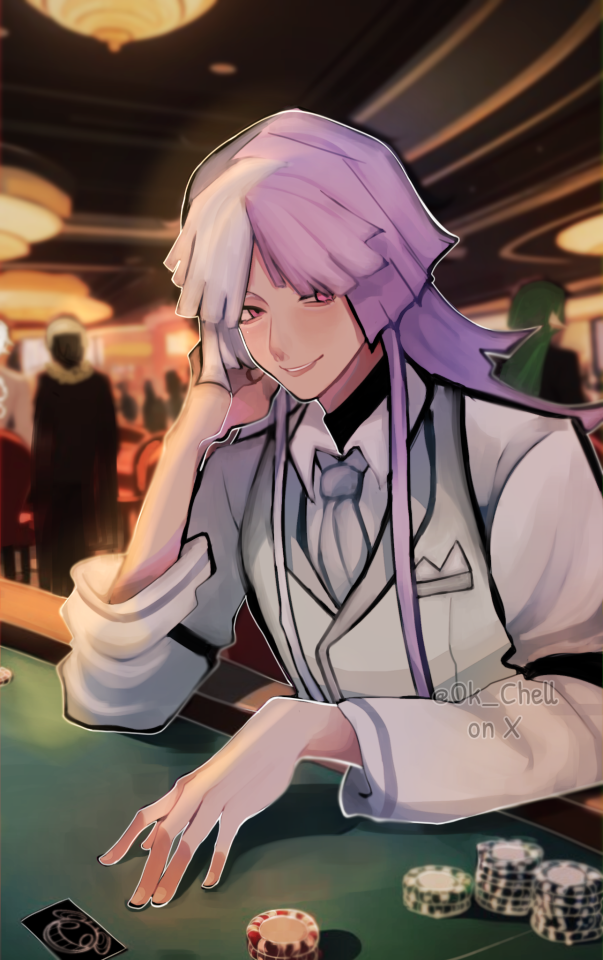
#uhhh uh hhh uh#sigma#the hand... the lil smile#im gonna combust#hes so gorgeous and perfect and charming and
321 notes
·
View notes
Text
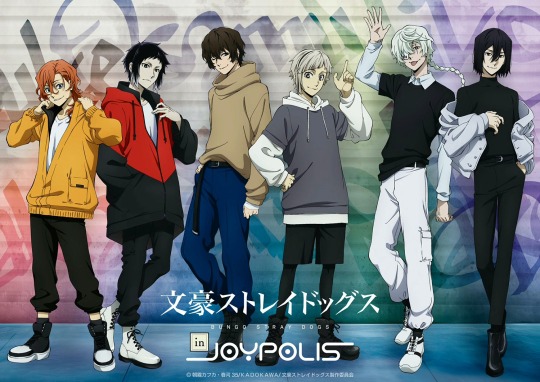
#HOY SHIT#NIKOLAI AND FYODOR LOOK SOOOOO BOYFRIENDS#very boyfriended#bungou stray dogs#nakahara chuuya#akutagawa ryuunosuke#dazai osamu#nakajima atsushi#nikolai gogol#fyodor dostoyevsky#for real fyodor looks fantastic#frail and beautiful byeeeeeee#nikolai in baggy pants!!#dazai's huge ass sweater!!
644 notes
·
View notes
Text

THANK YOU for 5k!! to celebrate ill be hosting a dtiys (draw this in your style) !!
rules are below the cut!
RULES ✨
- Redraw this in your own style (you don't need to do the background!! just Sigma is cool 👍)
- Post with the hashtag #koko5kdtiys and tag me in the entry!! (i want to reshare all entries so tagging me will definitely mean i don’t miss it!)
- Please do NOT trace or use AI or your entry will be disqualified
- Feel free to use your own Sigma design! Mine is a little different than canon so you can use your own hcs/design or keep it more as the canon design!
PRIZES ✨
- 1st place: Half body full color drawing
- 2nd place: Icon full color drawing
- 3rd place: Icon sketch drawing
DEADLINE is December 20th!
THANK YOU ALL FOR 5K!! I've met so many cool people on this app and had so much fun so I thought hosting something fun like this might be cool :D Thank you all for your continued support 🙇
Here's a version with no background for easy reference :D

1K notes
·
View notes
Text

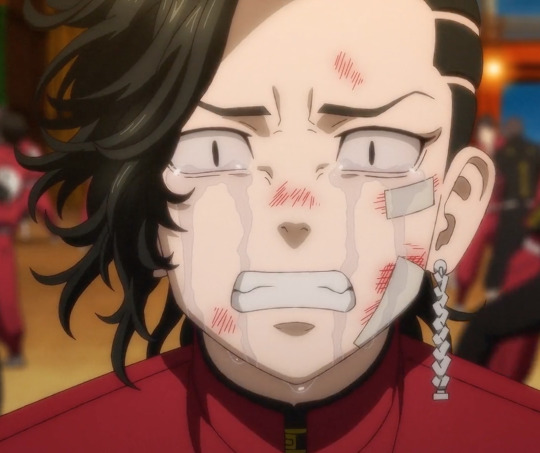
ok but the way they deliberately added this micro scene, where they're both in tears, that WAS NOT IN THE MANGA???
10000/10 adaptation choice, it was perfect. I needed them to hug and made un in that precise moment, they're both so tired and devastated
#I HAD NOT SEEN THAT TWEET#WONDERFUL CONTENT#im so glad they worked so lovingly!!#it just makes me happy#the animators work in proper conditions and they love tr and we all love tr and im just#im sensitive i love everything
220 notes
·
View notes
Text
From TR Expo (Nov 2023):

Koko: Inupi, has Akane-san been okay?
Inui: Yeah, she's been doing well.
Undisclosed adult, during the fire (flasback): I've got Inui-kun! You hurry up and get Akane!!
Inui: Well, people say puppy love usually doesn't work out for a reason, eh?
Koko: Oh shut it.
These extra sketched pages shown at TR Expo disclose how things went with Koko, Akane and Inui in the final timeline!
So, there it goes: Koko got to do what he would've wished in the previous timelines, erasing his main regret. He was the one to get Akane safely out of the fire. Both Inui siblings made it out unscathed, so Akane is alive!
But as far as Koko's initial feelings for Akane went, it was still regarded as a puppy love that, even under the "ideal" conditions, wasn't intended to get anywhere.
In the final TL, Koko ends up by Inui's side once again. It's fantastic!!
#tokyo revengers#tokyo revengers expo#inukoko#kokonui#kokonoi hajime#inui seishu#inui akane#tr expo#my translation stuff
142 notes
·
View notes